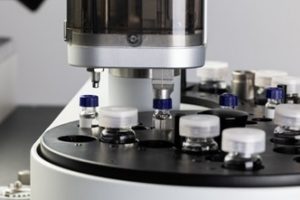Sample Preparation – Derivatization Extraction
What is Derivatization Extraction?
A derivatization extraction is where the analyte is converted into a product which has a similar chemical structure to the original analyte.
Why is Derivatization Extraction Important?
Derivatization extractions are often used to increase the detectability of an analyte. Polar compounds are often less volatile than non-polar compounds and therefore, can be difficult to separate by gas chromatography (GC) with increasing polarity there is also a higher likelihood of the compound interacting with active sites on the column. Derivatization extraction can also be used to improve the thermal stability of the analyte which also has benefits for GC analysis.
Using a derivatization extraction procedure can also help to improve selectivity.
Extraction Chromatography –
Derivatization is often critical for GC applications as compounds containing polar N-H groups and O-H groups that are liable to hydrogen bonding can be converted to nonpolar groups. If the compound is less polar it is more volatile and therefore more amenable to being analyzed by GC.
What are the different types of extraction techniques?
There are many different types of derivatization that may be used depending upon the compound that is being analyzed.
One such reaction is silylation – trimethylsilyl ethers are capable of improving the volatility of polar compounds. Functional groups that are often seen as problematic for GC applications such as, carboxylic acids, amines, thiols and phosphate groups can be derivatized. Silylation is the replacement of an acidic hydrogen with an alkylsilyl group. This replacement with an alkylsilyl group yields compounds that are less polar, more volatile and have greater thermal stability.
Another example of derivatization is esterification. Fatty acid methyl ester (FAME) analysis is a necessity for compliance with the US nutritional labelling and education act. Fatty acids can be difficult to analyze by GC because they are highly polar and will form hydrogen bonds leading to adsorption issues. To be able to differentiate between the differences exhibited by unsaturated fatty acids, neutralization of the polar carboxyl functional groups is necessary. The esterification of fatty acids to fatty acid methyl esters can be performed with an alkylation derivatization agent. A catalyst such as boron trichloride is also used in the esterification process.
Acylation is another commonly used method of derivatization and is often used to add fluorinated groups to the compound of interest. Acylation is used to reduce the polarity of amino, hydroxyl and thiol groups as well as adding halogenated groups for analysis by an electron capture detector (ECD). In contrast with silylation, acetylation reagents tend to react with highly polar, multi-functional analytes such as amino acids. Acetylation converts these multi-functional analytes into esters, thioesters and amides. The acylation are formed with acyl anhydrides, acyl halides and activated acyl amide reagents – the anhydride and acyl halides may form by-products which must be removed before GC analysis.
Advantages and Disadvantages of Derivatization Extraction
Derivatization extraction can increase the detectability of the target analyte. It is also able to allow for the analysis of compounds which are not directly amenable because they may have inadequate volatility or stability.
Some compounds may also produce poor chromatographs, derivatizing the compound may improve the chromatographic capability of the target analyte.
However, derivatization extraction is often more time consuming than other extraction methods. The reagents that are required are often difficult to handle as they may be moisture sensitive, like silylation reagents.
If you enjoyed this article, you might want to take a look at these other interesting reads:
https://scioninstruments.com/blog/sample-preparation-liquid-liquid-extraction/
https://scioninstruments.com/blog/sample-preparation-manual-solid-phase-extraction/
https://scioninstruments.com/blog/sample-preparation-choosing-a-sample-preparation-technique/

